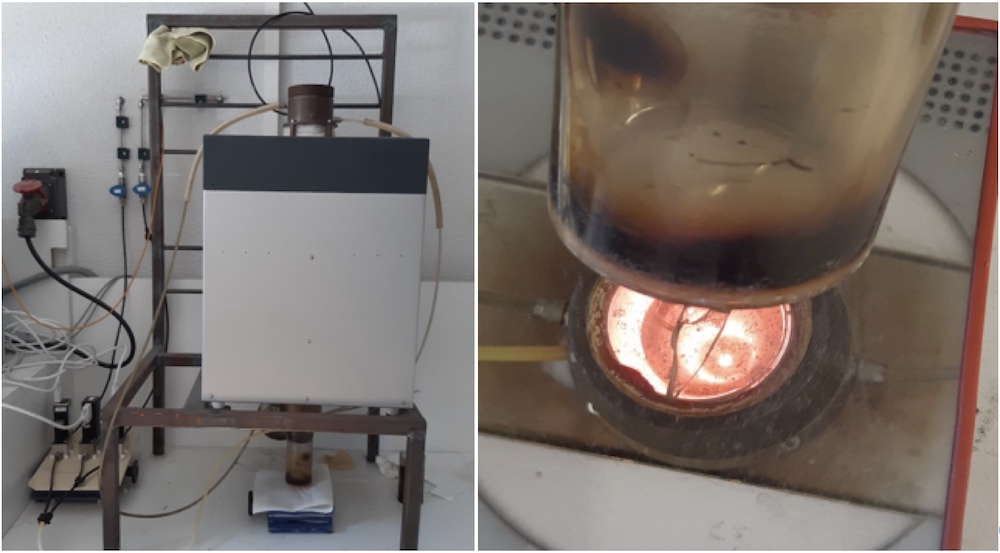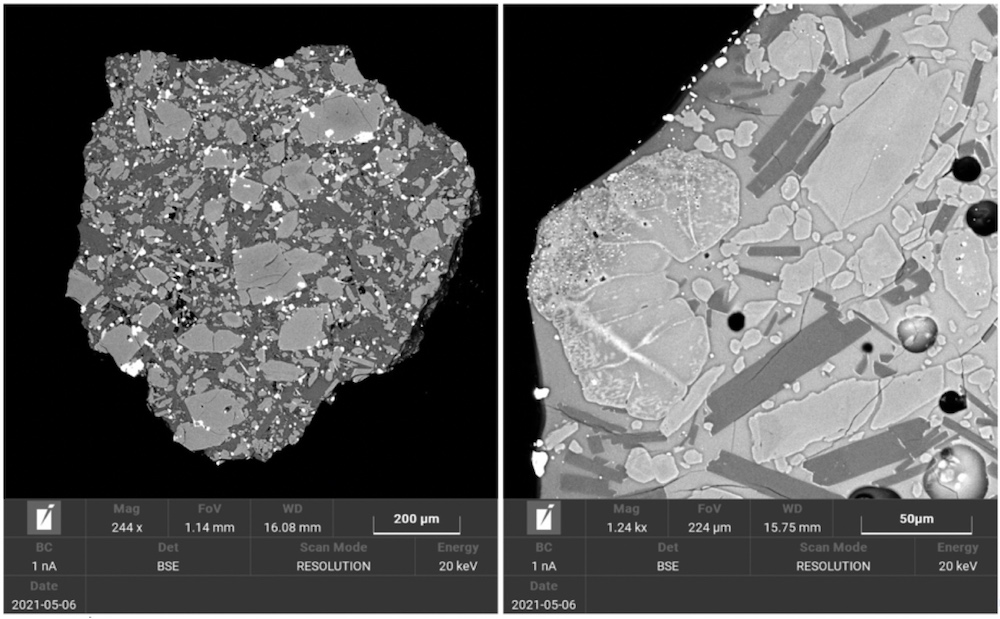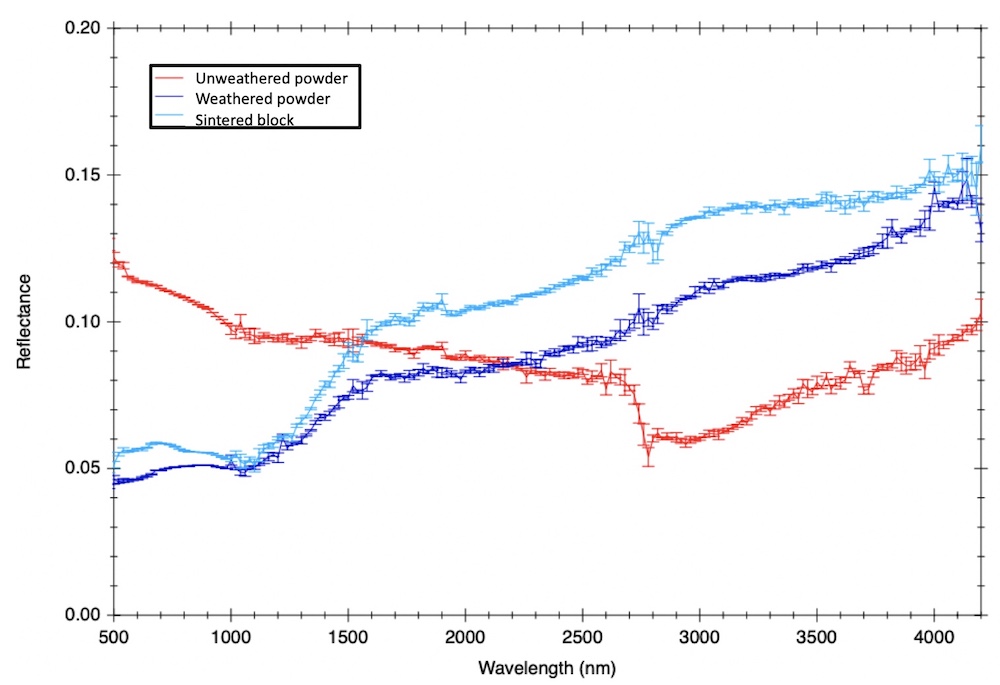Spectral behavior of regolith analogues weathered by heating under reducing conditions.
- 1CNRS-IRAP, Universite Paul Sabatier, CNES, Toulouse, France (jlasue@irap.omp.eu)
- 2CNRS-IPAG, Universite Grenoble Alpes, France
Introduction: Airless bodies of the Solar System present surface evolution due to space weathering. Their regolith is exposed to thermal cycling, cosmic and solar-irradiation, solar wind sputtering and micrometeorites bombardment and associated vaporization. With time, these materials accumulate optically active opaque particles such as nanophase metallic iron on the surface or rims of dust grains or larger iron particles. The density increase in iron particles modifies the spectral properties of the material with a lowering of the albedo, and of the amplitude of absorption bands, generally associated with a global reddening of the spectral slope [1, 2].
Previous studies have shown that nanophase iron particles that induce spectral properties typical of space-weathering will accumulate at the surface of olivine and pyroxene minerals at temperature conditions corresponding to micrometeorite impacts [3]. The skin depth of weathered material depends on the weathering process and minerals.
Context for Phobos studies: The moons of Mars, Phobos and Deimos, are some of the most enigmatic small bodies of the Solar System. Indeed, it is still debated in the community whether they originate from a large impact on Mars [4, 5], or if they are captured primitive asteroids [6]. The overall spectra of Phobos and Deimos have a strong red slope with no obvious diagnostic spectral features readily detected in the visible or near-infrared, similar to very primitive small bodies of the solar system. However, significant variations in the spectral slope indicate inhomogeneities of the material on the surface of Phobos, suggesting mixture of asteroidal and basaltic materials [7].
The Mars Moons Explorer (MMX) mission will bring back samples of Phobos to Earth in order to decipher the origin of the Martian Moons system [8]. The MMX InfraRed Spectrometer (MIRS) instrument on-board the mission is an infrared imaging spectrometer (0.9 to 3.6 μm) that will study the spectral properties of the surface of Phobos and Mars.
Laboratory analogue samples: In this context, laboratory analogues were ‘weathered’ artificially by submitting basalt (such as the Pic d’Ysson basalt already used for laboratory studies on the lunar regolith optical and spectrophotometric behavior [9]) and meteorite samples to near fusion temperature (1000°C) in an controlled-atmosphere furnace under reducing conditions (partial pressure of CO/CO2 of 96% corresponding to an oxygen fugacity of about 10-17) for exposure times of a 2, 4 and 8 hours (Figure 1; [10]).

Fig. 1: The controlled-atmosphere furnace at IRAP used for heating under reducing conditions [10].
Analysis of the weathered samples : A first comparison between unaltered Pic d’Ysson basalt grains and grains subjected to 4 hours heating at 1100°C under reducing conditions (fugacity of 10-17) is presented in Figure 2. Backscattered SEM images of basaltic grains before and after exposure are compared. The unaltered grain presents a typical crystalline structure with olivine, feldspars and ilmenite (bright minerals). Its bulk composition is given in Table 1.

Tab. 1: Elemental bulk composition of the Pic d’Ysson basalt unweathered (values given in wt.%).
When considering the altered basalt grain, the onset of alteration due to heating is clearly seen over a depth of about 30 microns (top left and left side of the images), with partial melting of the minerals and the appearance of nanophase metallic iron phases (presence of small white grains on the surface and inside the minerals).
Spectral analysis : The near infrared reflectance spectra of the ‘unweathered’ (pristine) and ‘weathered’ (heat-treated) samples (1050°C for 4 hours) are then acquired with the SHADOWS instrument at IPAG [11]. The resulting spectra are illustrated in Figure 3 (unweathered in red, weathered in blue). The weathered samples (powdered or sintered) demonstrate a significant change of slope with a strong visible reddening of the spectrum. At the same time the crystal infrared absorption bands depths are generally reduced.

Fig. 2 : SEM analysis showing the onset of heat diffusion and iron metal formation left: crystalline basalt grain unaltered showing the presence of olivine and feldspar crystals with ilmenite (bright minerals). right: apparition of nanophase Fe over a 30 μm depth after 4 hrs heating at 1100°C under reducing conditions.

Fig. 3 : NIR analysis of samples heated at 1050°C for 4 hours with SHADOWS [11] showing the reddening of the spectral slope between unaltered sample (red) and weathered samples (light blue: sintered; dark blue: powdered).
Conclusions and perspectives : Laboratory simulations show that heat-treated samples under reducing conditions can recreate the conditions under which regolith may be weathered in space with surface alteration of grains and appearance of nanophase iron. The analysis of the grains’ spectral properties indicates significant reddening and decrease of the absorption band depths as seen on space weathered surfaces. For the moment, the slopes reached remain lower than the ones seen on the surface of Phobos and Deimos. Now that the weathering concept has been demonstrated, further experiments will be performed using Mars analogues and meteorite samples to better constrain the possible materials on the surface of Phobos. Grain size distribution effects will also be explored.
Acknowledgment: this study was funded by CNES.
References: [1] Hapke, B. (2001) JGR, 106(E5), 10039-10073. [2] Pieters, C.M., & Noble, S.K. (2016) JGR, 121(10), 1865-1884. [3] Weber, I., et al. (2020) EPSL, 530, 115884. [4] Canup, R., & Salmon, J. (2018) Science advances, 4(4), eaar6887. [5] Bagheri, A., et al. (2021) Nature Astronomy, 1-5. [6] Hansen, B. M. (2018) MNRAS, 475(2), 2452-2466. [7] Glotch, T. D., et al. (2018) JGR: Planets, 123(10), 2467-2484. [8] Kuramoto, K., et al. (2021) Earth, Planets and Space. Submitted. [9] Souchon, A.L., et al. (2011) Icarus, 215(1), 313-331. [10] Toplis, M.J., & Corgne, A. (2002) Contributions to Mineralogy and Petrology, 144(1), 22-37. [11] Potin, S., et al. (2018) Applied optics, 57(28), 8279-8296.
How to cite: Lasue, J., Pinet, P., Beck, P., Toplis, M., Munsch, P., and Oustric, M.: Spectral behavior of regolith analogues weathered by heating under reducing conditions. , Europlanet Science Congress 2022, Granada, Spain, 18–23 Sep 2022, EPSC2022-840, https://doi.org/10.5194/epsc2022-840, 2022.

